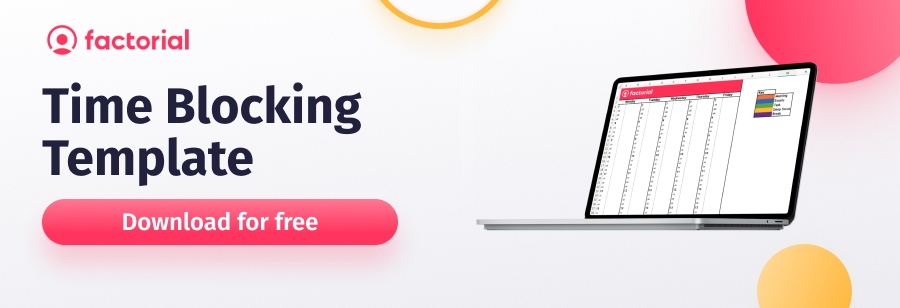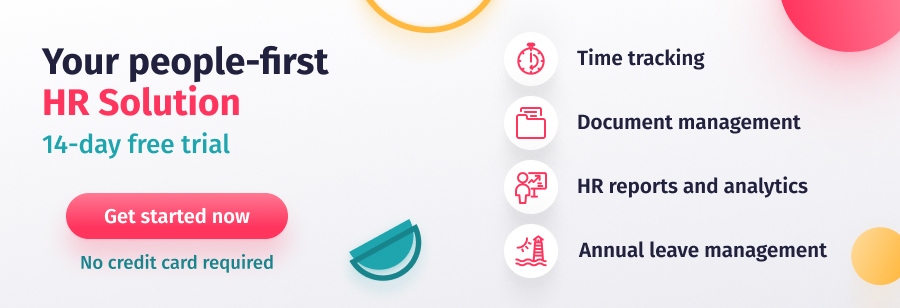What is time blocking?
Time blocking is a productivity tool or time management technique where you divide your day into sections of time and focus on one specific task or set of other similar tasks together during that time. It has a long and illustrious history, claiming Benjamin Franklin as an early proponent, going viral on TikTok in December 2021 and apparently used by the undeniably productive Elon Musk.
The American author and computer scientist Cal Newport, who writes about the intersection of technology and work, credits time blocking as the critical tool to achieving ‘deep work’ in the digital age. According to Cal’s deep work method, blocking time legitimises the removal of distractions, helping you immerse yourself in a specific task and ultimately work better and smarter.
This article outlines why its proponents believe time blocking is so effective as a time management technique and includes tips on how to be the most efficient when using it.
Table of Contents
Time Blocking, Time Batching, Time Boxing, and Time Tracking
Although these time management terms might sound similar and some concepts inter-relate, it’s important not to mix up time blocking with time batching, timeboxing, or tracking. There’s also day theming to consider too, another of the effective time management strategies used.
Time batching is where you collate similar tasks (such as answering emails, returning phone calls and scheduling social media posts) and work on them in one chunk of time; time batching is a crucial element of successful time blocking.
Timeboxing: not to be confused with time blocking. This is when you set yourself a specific period to achieve a whole task (for example, I will write 1500 words on time blocking in two hours).
Time tracking: a commercial device, rather than a productivity tool, used to record time spent on important tasks, often for charging purposes.
Day theming: different days of the week are allocated to specific areas of work to allow a greater focus; often used when someone has a role or working life with multiple functions; entrepreneurs often use day theming as their preferred time management technique as they can break their week up into days that focus on, for example, marketing, accounts or employees.
How Does Time Blocking Increase Productivity?
By setting blocks of time to work on specific tasks, you can improve the quality of your work and how much you can do. Time blocking improves your time management skills and increases productivity by:
- Helping you to allocate your time to the most critical tasks, ensuring they get done.
- Improving your focus: knowing you have a specific amount of time to work on a task makes it easier to switch off distractions and get into the flow of your work.
- Giving you back the time you lose when you switch between different tasks and have to take a few minutes to reorientate yourself to the new tasks.
- Letting you take control of your schedule and avoid the feeling of panic or overwhelm, which can stop you from working efficiently.

How to Time Block Your Day
Ready to start using this effective time management strategy? Here’s how to begin.
Firstly, remember these two fundamentals:
- Whether on paper or a screen, visually map out your work schedule so you know what meetings, deadlines and personal commitments you are working around. Some people like to put pen to paper as part of their process. In contrast, others prefer to use their digital calendar as it already has regular appointments and meetings and can be used to communicate with team members when you are available.
- Group similar tasks together (the time batching we talked about earlier). Note that you can use time batching for meetings too. Grouping meetings is a time management technique that can free up a block of time during the day. Just make sure you have breaks between them.
When you sit down to map out your day in time blocks, make sure you:
- Have already written your to-do list and know your priorities and all the tasks for the day, week, or month.
- Schedule your breaks and time out, as well as your essential tasks.
- Allow more time than you think you will need for specific tasks, especially when you first start using time blocking to manage your work.
- Think about your most productive hours and the expectations of your role and your team. For example, if you are more creative in the afternoon, it makes sense to block time for creative tasks then. Or, if your manager likes to hear from you first and last thing, a session at the beginning and end of the day on answering emails and responding to team communications ensures there are no concerns that you are meeting the requirements of the role.
- Share what you are doing with colleagues so they understand your work schedule, how you are working and respect your boundaries.
- Think about when you need to use ‘do not disturb’ to get into your work to complete tasks and when you would be happy to be interrupted.

The Benefits of Time Blocking as a Time Management Technique
Earlier, we discussed how time blocking is a time management technique that could make you more productive, but there are other benefits. Time blocking also:
- Counteracts burnout: time blocking allows you to schedule time for breaks, hobbies and personal commitments. With 79% of Brits experiencing work-related stress, according to a survey, a tool that helps people create a better work-life balance is undoubtedly a good thing.
- Reduces the feelings of overwhelm and panic: time blocking is a proactive approach to time management that also helps you to get all the tasks done, helping you feel more in control and improving your mental health.
- Teaches you about prioritizing tasks: it can be easy to get distracted when something new arrives on your desk. With time blocking, you learn that just because something is unexpected, it isn’t automatically a priority.
- It helps you stop procrastinating: if you have been putting a task off, allocating a specific period of the day can kickstart the process of getting it done. Making a plan helps you follow through on your intentions.
- Builds team spirit: using time blocking can contribute to a positive work culture where each individual’s time is respected, and the team together models a better work-life balance.
- Increases work satisfaction: time blocking helps you get into the flow of a task, doing the deep work that can ultimately lead to greater job satisfaction. Failing that, knowing you have met your priorities for the day normally feels good, doesn’t it?
- Avoids perfectionism dominating your working world: when you use time blocking, time batching, and time boxing, you set clear parameters for your work, which can help you accept when something is ‘good enough’.
- Helps those who are neurodiverse: the structure and focus of time blocking can help those whose brains find distractions particularly hard to ignore.

Limitations of Time Blocking
As with other time management techniques like the rapid planning method or the pomodoro technique, time blocking doesn’t work for everyone, so it’s worth bearing in mind the following points if you are considering using it to revolutionise your working day:
- Time blocking will only work if you have a prioritised list and a clear idea of the important tasks you need to get done, and which of the other tasks can wait.
- When you first start time blocking, it can feel as though you are spending long periods micro-scheduling your day when you could be getting on with work. The intensity of this work will reduce as you become more familiar with the approach.
- It can be harder to implement time blocking if you are in a reactive role or one involving many meetings. Time blocking can still be a valuable tool to help allocate the ‘free’ time you have to work on specific tasks but be realistic about how your working day functions. You may need to create a different approach for those urgent tasks that really cannot be ignored.
- If you need to get into the flow of what you are working on (Cal Newport’s deep work method), time blocking itself is not enough. To stay focused on a single task, you also need to be strict about not being disturbed, turn off notifications (including phone calls) on devices, and consider using time boxing to set yourself a specific amount of time to get something done.
- A common mistake people make when using time blocking is not giving a task enough time. Indeed, things often take longer than you think, so try to factor this in as much as you can within a busy schedule and daily life.
- Consider time blocking as a flexible tool, not a rigid framework. Invariably something will come up, or you won’t get all your tasks done in the allocated time, so have a system for noting down what still needs to be done and move on. Be kind to yourself – time blocking is a tool to help you get things done and have a better work-life balance, not beat yourself up when you don’t.
Lastly, a quick search will throw up any number of apps claiming to time block your life for you, and these can work very well for some people. However, the real key to knowing if this is the right time management technique for you is to be comfortable with the idea of spending time to work out how to spend your day best and to learn how to switch off distractions when you need to.









